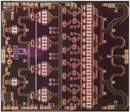Product Feature:

An X-band Phased-array Radar MMIC Chip Set
Mimix Broadband Inc., Houston, TX
Radio detection and ranging or RADAR has been around since its first implementation in the early 1900s when the use of radio waves was first used to detect the presence of ships in dense fog. The actual acronym was not coined until the early 1940s. X-band radar, in particular, has been around since the outset of World War II and continues to see extensive use. Typical X-band radar applications include air traffic control, detection of precipitation, speeding traffic and military use. Military uses include detecting and tracking aircraft, ships, missiles and other objects with the intention of harming any of our armed forces protecting our country and its interests. Various types of radar include continuous wave (CW), dual-pole, phased array, pulsed, single-pole and synthetic aperture radar (SAR). Many of the advanced X-band radars used today are typically based on active phased arrays requiring the use of many multiple phase array element sections.

